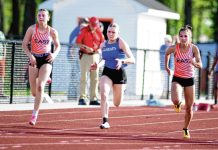WEST LAFAYETTE — Markell Jones was a bit of a football junkie when he was in high school. So it took his father by surprise when Jones would return from college on weekends and talk about his classes instead.
“He would come home and want to talk to me about flying and different stuff, and he wasn’t talking about football,” Jym Jones said of his son. “I was getting worried there for a minute.”
But not really.
Jym Jones has worked as a pilot for Cummins Inc. for nearly a decade, and Markell intends to follow in his father’s career path.
[sc:text-divider text-divider-title=”Story continues below gallery” ]
The Columbus East graduate enrolled in the professional flight program at Purdue. He already logged 68 hours in the air heading into December’s final exams. By semester’s end, Jones expects to be licensed to fly private, single-engine planes. He’ll start piloting jets as an upperclassman, something he hopes to do for a living once his football-playing days are behind him.
“I want to fly commercially after football’s over with, whenever that is,” Markell Jones said, “and then get on with an airline and make a career of that, because it’s just where I’ve always seen myself.
“I can’t be an office type of guy. I’ve got too much energy to do that. I have to be doing something fun.”
He’s been having a lot of that lately.
Ready for takeoff
Jones has always enjoyed running, especially with a football cradled in his arm, but he also developed an early interest in flying while tagging along with his father.
“He grew up around airplanes, and I used to take him to air shows,” Jym Jones said. “And from an early age, he would like to fly a flight simulator, Microsoft Flight Simulator, so I definitely saw the interest. There was a fascination there from grade school.
“As he got older in high school, and he said he wanted to be a pilot, I wasn’t sure if it was serious, but he said that’s all he wanted to do. That’s all he could see himself doing as far as a career.”
Which made Purdue an easy choice.
There aren’t many Division I schools with flight programs, and Purdue also offered the chance to be close to home and see immediate action on the gridiron. It also offered the opportunity to pilot a plane during his first semester on campus.
Since he had taken many a ride with his dad and logged countless hours on the computer pretending to fly, Jones wasn’t really nervous the first time he got up into the air with the controls in his hands. His maiden voyage was still a bit surreal, however.
“It definitely was,” he said.
“The fact that, ‘Oh, I’m flying the thing myself.’ And then I did 10 hours of solo,” Markell Jones said. “It was just another one of those milestone type of moments when you’re up there by yourself — it’s all you.”
Come spring, Jones will move on to studying instruments and continue logging hours on simulators and in the air as he works toward his commercial pilot’s license.
Jones expects to log about 170 flight hours and another 50 or so hours on simulators in the first four semesters alone. It’s much different from being stuck in a traditional classroom.
For a typical lesson, a student will meet the instructor in the dispatch area for a preflight briefing, said Pascal Nguyen, assistant chief flight instructor at Purdue’s School of Aviation and Transportation Technology. They will check the weather and see if it is suitable for the planned lesson, he said.
Some lessons will occur within 20 miles of Lafayette, whereas others will be long-distance flights of up to 275 miles, Nguyen said.
There are other differences, too. Some flights will be with the instructor, while others will be done by the student alone. Some will be during the day, with others at night.
But Jones was preparing himself mentally for flight well before he landed at Purdue.
Besides watching his dad, “I’ve always grown up playing flight simulator games on my computer and watching plane movies — ‘Top Gun,’ for example; I love ‘Top Gun.'”
Picking up speed
Jones quickly became the Boilermakers’ top gun on the gridiron this fall.
Indiana’s Mr. Football a year ago, Jones graduated early from high school and enrolled at Purdue in January. That gave him an opportunity not only to start in on his course load but to make a smoother transition to college life, both on and off the football field.
While fellow students still had a reasonable acclimation period, Jones had a whole semester to get ready.
“We had a limited amount of football, and I was able to really jump into school a lot and get a good head start,” he said.
That gave Jones a leg up on the competition at running back, and he was able to work his way up the depth chart right away.
He was a factor immediately this fall, carrying 12 times for 72 yards and a 36-yard touchdown in the season opener at Marshall. His breakout performance came at Big Ten champion Michigan State, where he ran for 157 yards and two more scores, including a 68-yarder.
Jones finished the season with 875 yards and 10 touchdowns on the ground, as well as 34 catches for 239 more yards and another touchdown. He was the lone Boilermaker on the Big Ten’s All-Freshman Team.
Coming in early and having the chance to go through spring practice helped smooth Jones’ transition to the college game. Many freshman athletes talk about struggling at first with the speed and physicality at the Division I level, but Jones was pleasantly surprised at how much he didn’t struggle — something he attributed to a summer of hard work with strength and conditioning coach Duane Carlisle and his staff.
“I was actually surprised about the speed,” Jones said. “Against Michigan State, I had that long touchdown run — those were corners and safeties, and I was running away from them.”
Up, up and away
Most college football coaches might not want their star freshman running back learning how to fly planes in his spare time. But Purdue coach Darrell Hazell isn’t like most coaches.
Former Boilermaker running back Brandon Cottom, now with the Seattle Seahawks, also studied professional flight technology, so Jones knew he would have Hazell’s blessing.
“They really encourage you to challenge yourself academically as well as in football,” Jones said, “so that was never a concern to them.”
“The only person that was uneasy about it was my running backs coach (Jafar Williams). He said he’d never fly with me if I got anything less than an ‘A.’ He’s already kind of squeamish when it comes to flying planes.”
Jones, on the other hand, never has been — and he’s even more excited now that he will be able to come back home and be able to go up in the air with his dad.
“I’m looking forward to that,” Jym Jones said. “I’ll be his co-pilot, and I’ll sit over there and watch him go to work.”
[sc:pullout-title pullout-title=”Taking flight” ][sc:pullout-text-begin]
How does one become a pilot? Here’s a look at the flight instruction portion of Purdue’s professional flight program.
First semester
Students take private pilot ground school and log about 50 flight hours to get their private pilot’s license.
Second semester
Students take Commercial Flight 1 to build hours and learn maneuvers for their commercial pilot’s license. The semester includes about 40 more flight hours.
Third semester
Instrument Pilot ground school prepares students for instrument flight knowledge. Commercial Flight 2, which includes another 40 flight hours, helps to refine maneuvers for commercial pilot’s license and to introduce instrument flying maneuvers. Instrument Simulator 1, which includes about 26 hours on a simulator, introduces navigation, approaches and landings at airports in inclement conditions with low visibility.
Fourth semester
Students will go through Commercial Pilot ground school and take Instrument/Commercial Flight with about 40 flight hours to get their instrument rating and commercial pilot’s license. Instrument Simulator 2 includes 26 more simulator hours to refine instrument approaches and procedures with abnormal conditions such as instrument failures. Students have the option of taking an extra course to get a flight instructor license or instrument instructor license.
Fifth semester
Turbine Flight ground school teaches Embraer Phenom 100 systems and operational knowledge. Students do about 10 flight hours in Multi-Engine Flight to prepare for commercial and instrument multi-engine pilot’s license. The Phenom Simulator (about 50 hours) introduces a crew environment — working with a co-pilot rather than being the sole pilot — and turbine flight operations, including various abnormal situations and emergencies.
There is an option to flight instruct for Purdue and build hours. Additionally, selected students may fly as a co-pilot on university transportation trips with actual passengers on a Cirrus SR-22. Both of those options are also available in semesters six through eight.
Sixth semester
Turbine Flight allows students to actually fly an Embraer Phenom 100 to learn the maneuvers required for jet type rating and high-altitude endorsement. Optional university transportation trips as a co-pilot can also be taken on the Phenom 100 or Nextent 400xti.
Seventh semester
Students will do about 30 hours on a CRJ-700 regional jet simulator to improve crew environment procedures and turbine operations experience.
Eighth semester
Students will continue to build flight hours with the options to flight instruct for Purdue and to fly as a co-pilot on university transportation trips.
[sc:pullout-text-end]




